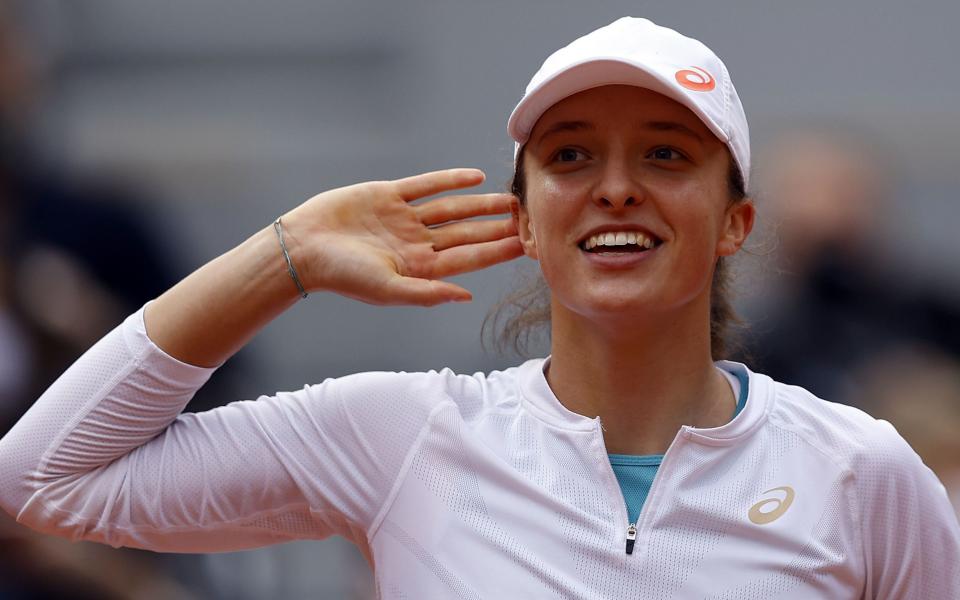The making of Iga Swiatek, the teenager tipped to become the next tennis superstar

Whatever happens to Iga Swiatek in Saturday’s French Open final, she can reflect on a breakthrough year – and one that began with an off-season training block at a David Lloyd Club in Cambridge.
Swiatek lives in Raszyn, a suburb of the Polish capital Warsaw, and is coached by a compatriot in Piotr Sierzputowski. But she has a British mentor in Nick Brown, a 59-year-old whose own playing career peaked when he knocked Goran Ivanisevic out of Wimbledon in 1991.
In December, she nipped over to England for a week of training. Brown also coaches the Cambridge University tennis team so he recruited the captain – Michal Kaminski, who happens to be Polish – as a hitting partner.
“The members loved watching what we were doing,” Brown told Telegraph Sport, “and some of the younger kids knew who Iga was. She said ‘hi’ to them, did photographs. It was a great experience for them to see someone training at that level.”
At that stage, Swiatek was ranked 60 in the world, with a CV that included a run to the fourth round of last year’s French Open, plus a junior Wimbledon crown. Not bad for a girl who only turned 19 in May.

But 2020 has seen her climb to a new level. First with another fourth-round appearance in January’s Australian Open, and now with this extraordinary showing in Paris, where she has dropped zero sets and only 23 games on her way to the final.
“When I spoke to Piotr before Paris, he said that Iga was struggling,” recalled Brown, in relation to a post-lockdown record which then stood at two wins from five matches.
“I said, ‘Look, she has happy memories here from juniors [where Swiatek won the doubles in 2018, while also reaching the last four in singles]. As a player, when you go back somewhere where you have been successful, you get good vibes.
“The win over [top seed] Simona Halep was a game-changer. I just said ‘Do your warm-down, take yourself out, go by the river, relax, have an ice-cream, get away from tennis.’ The danger of the big event is that you are dealing with so much attention. But then this year is a weird tournament, with so few fans and hardly any media there in person – so maybe that helps.”
Brown had just finished a seven-year stint as British Fed Cup captain when the Polish Tennis Federation approached him in 2005. “There was a lot of infighting at the time, so they wanted an outsider to come in and raise the standard.
“Their entire budget at that time was around £1million. I remember going for my interview at a two-bedroom flat in a building left over from World War II – and that was their headquarters. They are very resourceful, because they have to be. And like a lot of people from that background, Iga has an incredible hunger to succeed.”
Welcome to the final 👏
19-year-old @iga_swiatek dominates Podoroska 6-2 6-1 to become the first 🇵🇱 woman in the Open Era to reach the title match in Paris.#RolandGarros pic.twitter.com/48CIv1C8vO— Roland-Garros (@rolandgarros) October 8, 2020
Initially, Brown helped to develop a group of world-class doubles players in Mariusz Fyrstenberg, Marcin Matkowski and Lukas Kubot, all of whom would qualify regularly for the ATP Finals. He also kept an eye on Jerzy Janowicz, the 6ft 8in giant who pushed Andy Murray to four sets in the 2013 Wimbledon semi-final.
Swiatek, though, is made of different stuff. After watching her effortless demolition of Nadia Podoroska in Thursday’s semi-final, the Eurosport pundit Mats Wilander suggested that “I genuinely believe that Iga can be the one. I think she’s there to be a grand-slam champion, multiple times.”
Brown first saw her during that 2018 French Open juniors event, where she happened to beat Sofia Kenin – her opponent in Saturday’s final – in the quarter-finals. A couple of weeks later, they were working together on a grass court in Walsall in preparation for Wimbledon.
“She had never played a competitive match on grass before, and her mindset was that ‘I hate the stuff.’ I said, ‘Give it a little time.’ She rolled her sleeves up and beat the top seed in the first round, and then in every match she was improving – adding a bit of variety to the slice, coming in to the net more to finish the point. I could see how quickly she took information on board. After she won the tournament, I asked her about grass again and she said, ‘I love it now.’
“Our bond really started there. She has a team of people around her where everybody trusts each other and there are no egos – something that is also true of Iga herself. She reminds me of someone like Pat Rafter, just a sensible lad who never changed despite all his success. She was 16 when she started to build a WTA ranking, but she insisted that she wanted to finish school. Last year, she only played 12 tournaments, so to be top 60 was pretty impressive.
“I think Coco Gauff has helped. The spotlight has been on Coco so much that it has helped Iga develop quietly. At the start of the year, she was using her court craft and her drop-shot a lot. But in Paris she’s just been smacking it – the stats are showing her average speeds are up there with [recent US Open champion] Dominic Thiem. It’s been great to watch. And the exciting thing, as a coach, is that there’s still so much room to improve.”

